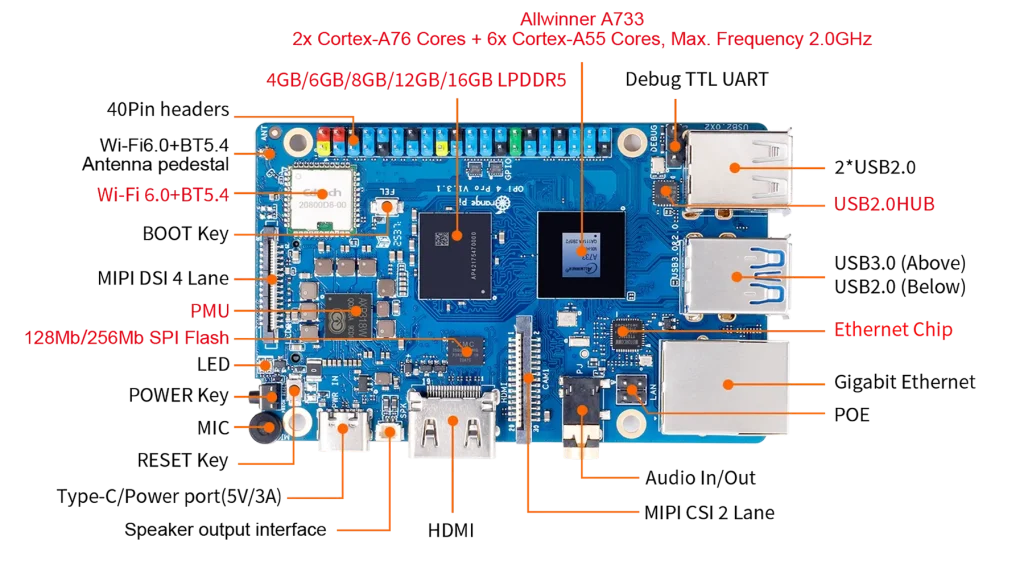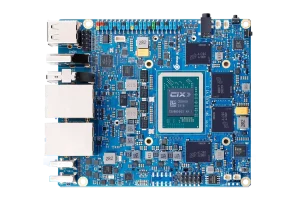If you’re looking for a powerful yet affordable single-board computer (SBC), the Orange Pi 4 and Orange Pi 4 Pro are two strong options that often leave users wondering which one to choose. Both boards are compact, energy-efficient, and packed with modern features — but they serve slightly different needs. In this comparison, we’ll break down the key differences between Orange Pi 4 and Orange Pi 4 Pro, covering performance, design, pricing, and ideal use cases to help you pick the right board for your next tech project.
Orange Pi 4
The Orange Pi 4 is an open-source single-board computer powered by the Rockchip RK3399 (a dual-Cortex-A72 + quad-Cortex-A53 big.LITTLE architecture). It supports 4K output, dual camera interfaces, Gigabit Ethernet, and runs Android, Ubuntu or Debian. This board is suited to makers, developers or hobbyists who want a capable SBC for media, server or embedded projects.
Orange Pi 4 Pro
The Orange Pi 4 Pro builds on an Allwinner A733 SoC with dual-Cortex-A76 and hexa-Cortex-A55 cores, plus a RISC-V microcontroller and an on-board NPU (3 TOPS) for AI/edge tasks. It offers LPDDR5 memory up to 16 GB, NVMe M.2 storage, WiFi 6 and PoE support. It’s aimed at users building advanced applications like robotics, industrial gateways, AI inference or compact servers.
|
Spec category |
Orange Pi 4 |
Orange Pi 4 Pro |
|
SoC / CPU |
Rockchip RK3399 — 6-core ARM 64-bit processor: 2× Cortex-A72 + 4× Cortex-A53, main frequency up to 2.0 GHz. |
Allwinner A733 — octa-core: 2× Cortex-A76 (up to 2.0 GHz) + 6× Cortex-A55 (up to ~1.79–1.8 GHz); includes a single-core RISC-V real-time core. |
|
Memory |
LPDDR4 — available in 3 GB / 4 GB variants (model depends on SKU). eMMC option (16 GB) on some SKUs. |
LPDDR5 — configurable up to 16 GB (4 / 6 / 8 / 12 / 16 GB options reported); optional eMMC modules (16 / 32 / 64 / 128 GB). |
|
GPU / VPU / NPU |
GPU: Mali-T860 (RK3399 platform) — supports 4K video output (HW decode/encode capabilities per RK3399). |
GPU: Imagination BXM-4-64 (on A733). VPU: 8Kp24 H.265/VP9/AVS2 decode and 4Kp30 encode reported. NPU: on-board AI accelerator ≈ 3 TOPS (INT8) for inference. |
|
Display / Video outputs |
HDMI 2.0 (Type-A) supporting 4K@60 and DisplayPort 1.2 (4K@60) on some variants; dual MIPI-DSI supported. |
HDMI 2.0 (4K@60) and 4-lane MIPI-DSI display interface; dual/single MIPI CSI camera options listed. |
|
Networking (wired) |
Gigabit Ethernet (Realtek RTL8211E). |
Gigabit Ethernet; PoE support listed as possible option on vendor/coverage. |
|
Wireless |
Some SKUs include Wi-Fi + Bluetooth (AP6256 — 802.11 a/b/g/n/ac, BT 5.0) depending on model. |
Wi-Fi 6 and Bluetooth 5.4 capability reported (onboard module on Pro SKU). |
|
USB / Expansion |
USB: USB 3.0 + USB 2.0 ports; USB-C power on some SKUs; mini-PCIe (on some RK3399 variants). GPIO: 40-pin header (I2S/I2C/SPI/UART). |
USB: at least 1× USB 3.0 and multiple USB 2.0 ports reported; M.2 M-Key (PCIe 3.0) slot for NVMe SSD; microSD slot; GPIO headers and audio I/O. |
|
Camera |
2× MIPI-CSI camera connectors (MIPI_RX0, MIPI_RX1). |
MIPI-CSI camera interface(s) — coverage lists at least one 2-lane CSI and dual MIPI support on some variants. |
|
Storage |
microSD slot; optional eMMC (16 GB option); USB storage. |
microSD slot; M.2 NVMe via PCIe 3.0 (M-Key); optional eMMC modules (16–128 GB). |
|
Power |
DC 5V/3A via Type-C or barrel jack (varies by board/sku). |
Typical SBC power via DC/Type-C (specs vary by board SKU); NVMe and LPDDR5 increase peak power needs — recommended good PSU and thermal solution. |
|
OS support / Images |
Android (8.1) and several Ubuntu/Debian releases historically supported on RK3399 Orange Pi images; mature RK3399 ecosystem. |
Vendor/press indicate Android and Linux support planned; early adopters should check vendor downloads for up-to-date images and kernel/driver support. |
|
Typical form / size |
91 × 55.7 mm (typical SBC form factor for Orange Pi 4 variants). |
Compact SBC (approx. 3.5 × 2.2 in reported) — small single-board computer form. |
Orange Pi specs Aspects considered
- Ease of use (setup, software images, learning curve)
- Features (I/O, connectivity, storage, expandability)
- Performance (CPU, GPU, NPU, memory)
- Pricing (typical street / launch positioning)
- Support (OS images, community, documentation, vendor updates)
- Power & thermals (power delivery, cooling needs)
- Use cases (typical project types each suits)
- Upgradeability & longevity (M.2, eMMC, memory options)
Orange Pi 4 vs Orange Pi 4 Pro Quick tech snapshot
-
Orange Pi 4: RK3399-based 6-core SBC (dual Cortex-A72 + quad Cortex-A53), LPDDR4 memory, aimed at general SBC tasks and media/edge projects.
-
Orange Pi 4 Pro: Newer Allwinner A733 octa-core board (2×A76 + 6×A55) with LPDDR5 up to 16 GB, PCIe/NVMe, Wi-Fi 6 and an on-board NPU for edge AI.
1) Ease of use
Orange Pi 4
- Setup is straightforward for users familiar with SBCs: standard boot from microSD/eMMC and available Android/Ubuntu/Debian images from Orange Pi. Requires some familiarity with SBC flashing and Linux.
- Broad range of community tutorials exist (older RK3399 boards have been around for years), so troubleshooting resources are plentiful.
Orange Pi 4 Pro
- Similar basic setup (microSD/eMMC/optional NVMe), but newer hardware (LPDDR5, PCIe NVMe, Wi-Fi 6) may have fewer mature images at launch; expect some initial driver/firmware refinement.
- If you rely on stable, long-tested Linux images, you may encounter early-generation teething issues until community/vendor support matures.
Orange Pi 4 gives a slightly gentler experience for users who prefer tried-and-tested images; 4 Pro offers modern features but may require more hands-on driver/OS work early on.
2) Features (I/O, connectivity, storage, expansion)
Orange Pi 4
- Standard RK3399 feature set: HDMI 2.0, Gigabit Ethernet, USB 3.0/2.0, MIPI camera/display, optional eMMC, and GPIO headers. Good general-purpose I/O for projects.
Orange Pi 4 Pro
- More modern connectivity: Wi-Fi 6, Bluetooth 5.4, Gigabit Ethernet with possible PoE support, HDMI 2.0, USB 3.0, dual MIPI interfaces, and an M.2 M-Key slot with PCIe 3.0 (NVMe SSD) plus optional eMMC. On-board RISC-V microcontroller and NPU (approx. TOPS reported) add embedded/AI capabilities.
4 Pro expands connectivity and expansion (NVMe, Wi-Fi 6, NPU) over the original 4, making it more suitable where fast storage, wireless performance, or on-board AI is required.
3) Performance (CPU, GPU, NPU, memory)
Orange Pi 4
- RK3399: 2×Cortex-A72 + 4×A53 — strong multi-core and single-thread for its era, good for media decoding and general compute. GPU capable of driving 4K output. Performance is well understood from RK3399 boards.
Orange Pi 4 Pro
- Allwinner A733: newer big cores (Cortex-A76) + efficient A55 cores and LPDDR5 memory up to 16 GB — expected higher sustained CPU throughput and memory bandwidth. Includes an NPU (~up to 3 TOPS reported in some briefings) for inference tasks, giving it a clear edge for edge-AI workloads.
For raw and AI-inference performance, 4 Pro is the superior platform; Orange Pi 4 remains competitive for general media, desktop-like workloads and older RK3399-optimized software.
4) Pricing
Orange Pi 4
- Historically positioned as a value RK3399 board (examples around $50–$120 depend on RAM/eMMC options and seller). Widely available used/new at various price points.
Orange Pi 4 Pro
- Launched as a higher-end product (pricing depends on RAM and eMMC options); expected to command a premium over legacy RK3399 boards because of LPDDR5, NVMe, Wi-Fi 6 and AI features. Recent coverage lists it alongside modern SBCs aimed at Pi-5 competitors.
Expect the 4 Pro to cost noticeably more than the original 4; choose based on whether the extra connectivity, storage speed and AI features justify the premium for your project.
5) Support (software images, community, docs)
Orange Pi 4
- Long-standing RK3399 ecosystem: multiple Linux and Android images available from Orange Pi and third-party projects; larger body of community knowledge and benchmarks.
Orange Pi 4 Pro
- Vendor pages and press coverage list specs and suggested OS support, but community support and stable mainline kernel integration may lag the older RK3399 boards by months. Monitor official downloads and community forums for kernel/driver updates.
If you need broad, mature community support now, Orange Pi 4 has the advantage; 4 Pro will likely catch up, but early adopters should expect occasional driver/workflow work.
6) Power & thermals
Orange Pi 4
- RK3399 can run hot under sustained load; many users add passive or active cooling for heavy tasks (video encode, big computational loads). Power via barrel jack or USB-C depending on board variant.
Orange Pi 4 Pro
- Faster cores and NVMe/LPDDR5 can increase power draw; expect the board to need good thermal management for sustained high-load or NPU inference runs, designs typically include thermal pads/heat sinks and may benefit from active cooling.
Both can need cooling for continuous heavy workloads; 4 Pro’s higher performance headroom means more attention to cooling and power delivery.
7) Use cases
Orange Pi 4 — good fit for:
- Media boxes, small servers, dev work where RK3399 performance is sufficient, robotics prototypes without heavy AI inference, and users wanting an established software ecosystem.
Orange Pi 4 Pro — good fit for:
- Edge AI inference, robotics with on-board NPU, compact NAS or servers using NVMe, industrial gateways requiring Wi-Fi 6 and higher memory capacity, and projects needing higher sustained CPU/memory throughput.
8) Upgradeability & longevity
Orange Pi 4
- eMMC options and microSD; less headroom for future performance upgrades aside from storage and external modules.
Orange Pi 4 Pro
- NVMe via M.2, wider LPDDR5 memory options up to 16 GB, and modern wireless stack give it more future-proofing for demanding applications.
Final Recommendations
- Choose Orange Pi 4 if you want a proven RK3399 board with broad community support, lower entry cost (depending on seller), and solid media/desktop performance without AI/PCIe/NVMe needs.
- Choose Orange Pi 4 Pro if you need modern connectivity (Wi-Fi 6), NVMe storage, higher CPU/memory bandwidth and on-board NPU for edge AI — accept that software drivers/images may be less mature at launch.
Orange Pi 4 vs Orange Pi 4 Pro: Pros and Cons
Both Orange Pi 4 and Orange Pi 4 Pro are single-board computers designed for developers, makers, and hobbyists.
They run Linux or Android and can power small servers, smart devices, and embedded projects.
The Orange Pi 4 is older but well-tested, while the Orange Pi 4 Pro is newer, faster, and built for more demanding uses like AI and robotics.
Orange Pi 4
Pros
- Easy to set up and use with available OS images.
- Wide community support and online tutorials.
- Good performance for media, web, and small server tasks.
- Supports Android and major Linux distributions.
- Lower power draw and simpler cooling needs.
- Affordable and widely available.
Cons
- Limited to 4 GB RAM (less room for heavy apps).
- No NVMe or PCIe expansion slot.
- Slower LPDDR4 memory compared to newer boards.
- Older GPU; less efficient in modern workloads.
- Fewer wireless and high-speed connectivity options.
- Not designed for demanding AI or data-heavy projects.
Orange Pi 4 Pro
Pros
- Powerful CPU (Cortex-A76 cores) with fast LPDDR5 memory.
- Built-in NPU for on-board AI and image processing.
- Supports NVMe SSDs through M.2 PCIe slot.
- Offers Wi-Fi 6 and Bluetooth 5.4 for faster connections.
- Up to 16 GB RAM for multitasking and large workloads.
- Better graphics and video support (up to 8K decoding).
- Compact, modern design with strong connectivity options.
Cons
- Higher cost than the older model.
- Software and driver support still maturing.
- Needs better cooling for heavy or long workloads.
- Early users may face setup or compatibility issues.
- Slightly higher power consumption.
Final Verdict: Orange Pi 4 vs Orange Pi 4 Pro
The Orange Pi 4 is a solid and reliable board for everyday use. It’s easy to handle, affordable, and well-supported by the community. This model fits beginners, students, and hobbyists who want to learn, build small projects, or run light home servers without much setup trouble.
The Orange Pi 4 Pro, on the other hand, is built for professionals, engineers, and advanced makers. With its faster CPU, stronger GPU, and built-in NPU, it handles demanding tasks like AI, robotics, and edge computing with ease. It’s also suitable for small businesses or research teams that need stable high-speed performance and modern connectivity.
If you’re starting out or working on simple, budget-friendly projects, go with the Orange Pi 4.
If you need more power, better speed, and room to grow, the Orange Pi 4 Pro is the smarter choice.
Both boards can perform well. the right one depends on your goals, not the price tag. Choose what helps you build confidently and move forward.











